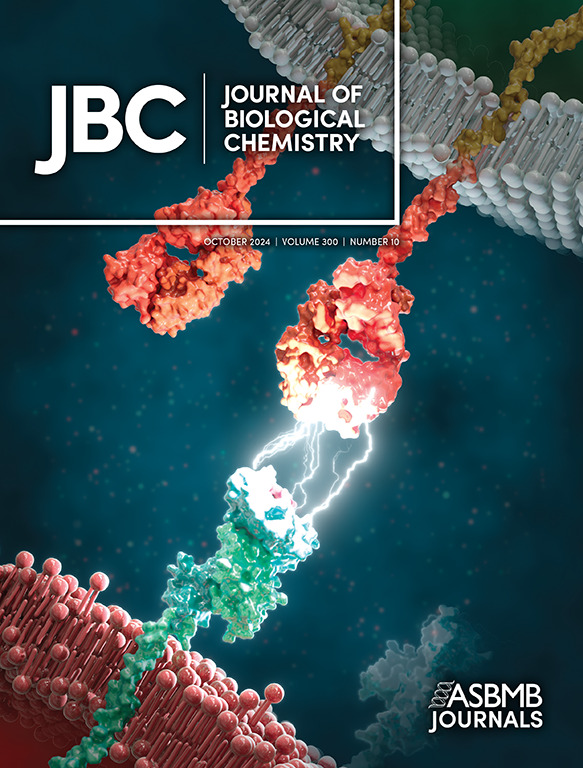YEATS2 O-GlcNAcylation Promotes Chromatin Association of the ATAC Complex and Lung Cancer Tumorigenesis.
IF 4
2区 生物学
Q2 BIOCHEMISTRY & MOLECULAR BIOLOGY
引用次数: 0
Abstract
The intracellular O-linked N-acetylglucosamine (O-GlcNAc) modification is known to be enriched in the nucleus and on chromatin, but many of its chromatin targets remain to be identified. Herein we demonstrate the O-GlcNAcylation of YEATS Domain Containing 2 (YEATS2), a subunit of the chromatin Ada-two-A-containing (ATAC) complex and a reader of histone H3K27ac. We show that YEATS2 interacts with the O-GlcNAc transferase (OGT) and further pinpoint its major O-GlcNAcylation site to be Thr604 using electron transfer dissociation mass spectrometry. O-GlcNAcylation promotes the chromatin association of YEATS2, and the affinity between YEATS2 and other ATAC components on chromatin, such as ZZZ3, GCN5 and PCAF. Downstream, YEATS2-T604A mutants attenuated the ATAC-dependent histone H3K9ac levels and inactivated the expression of essential ribosomal genes as shown in chromatin immunoprecipitation assays. Further, xenograft experiments show that YEATS2 O-GlcNAcylation promotes lung cancer tumorigenesis. Our work reveals the critical role of YEATS2 O-GlcNAcylation in stabilizing the ATAC complex on chromatin and expands the chromatin substrates of OGT.YEATS2 o - glcn酰化促进ATAC复合物的染色质关联和肺癌的发生。
已知细胞内o -连接n -乙酰氨基葡萄糖(O-GlcNAc)修饰富集于细胞核和染色质上,但其许多染色质靶点仍有待确定。在这里,我们展示了YEATS结构域2 (YEATS2)的o- glcn酰化,YEATS2是染色质Ada-two-A-containing (ATAC)复合体的一个亚基,也是组蛋白H3K27ac的一个读取器。我们发现YEATS2与O-GlcNAc转移酶(OGT)相互作用,并利用电子转移解离质谱进一步确定其主要的O-GlcNAc酰化位点为Thr604。o - glcn酰化促进了YEATS2的染色质结合,以及YEATS2与染色质上的其他ATAC成分(如ZZZ3、GCN5和PCAF)之间的亲和力。下游,YEATS2-T604A突变体减弱atac依赖性组蛋白H3K9ac水平,并灭活必需核糖体基因的表达,如染色质免疫沉淀试验所示。此外,异种移植实验表明,YEATS2 o - glcn酰化促进肺癌的发生。我们的工作揭示了YEATS2 o - glcn酰化在稳定染色质上的ATAC复合体和扩展OGT的染色质底物中的关键作用。
本文章由计算机程序翻译,如有差异,请以英文原文为准。
求助全文
约1分钟内获得全文
求助全文
来源期刊

Journal of Biological Chemistry
Biochemistry, Genetics and Molecular Biology-Biochemistry
自引率
4.20%
发文量
1233
期刊介绍:
The Journal of Biological Chemistry welcomes high-quality science that seeks to elucidate the molecular and cellular basis of biological processes. Papers published in JBC can therefore fall under the umbrellas of not only biological chemistry, chemical biology, or biochemistry, but also allied disciplines such as biophysics, systems biology, RNA biology, immunology, microbiology, neurobiology, epigenetics, computational biology, ’omics, and many more. The outcome of our focus on papers that contribute novel and important mechanistic insights, rather than on a particular topic area, is that JBC is truly a melting pot for scientists across disciplines. In addition, JBC welcomes papers that describe methods that will help scientists push their biochemical inquiries forward and resources that will be of use to the research community.
 求助内容:
求助内容: 应助结果提醒方式:
应助结果提醒方式:


